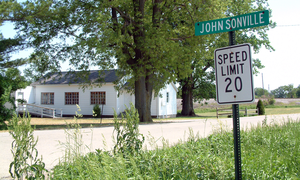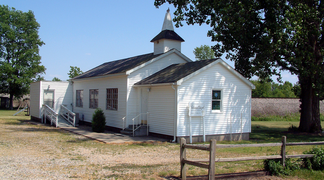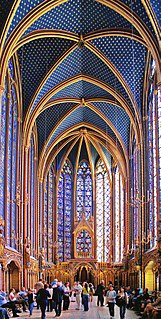
The Sainte-Chapelle is a royal chapel in the Gothic style, within the medieval Palais de la Cité, the residence of the Kings of France until the 14th century, on the Île de la Cité in the River Seine in Paris, France.
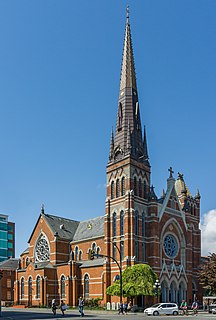
St. Andrew's Cathedral is the Roman Catholic cathedral for the diocese of Victoria in British Columbia, Canada. Built in the High Victorian Gothic style, St. Andrew's was Victoria's third cathedral to be built.
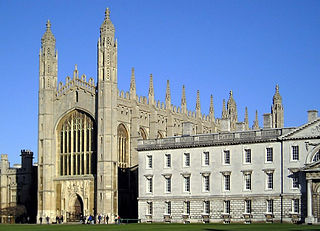
King's College Chapel is the chapel at King's College in the University of Cambridge. It is considered one of the finest examples of late Perpendicular Gothic English architecture. The chapel was built in phases by a succession of kings of England from 1446 to 1515, a period which spanned the Wars of the Roses. The chapel's large stained glass windows were not completed until 1531, and its early Renaissance rood screen was erected in 1532–36. The chapel is an active house of worship, and home of the King's College Choir. The chapel is a significant tourist site and a commonly used symbol of the city of Cambridge.

The Cathedral of St. John the Baptist is the mother church of the Roman Catholic Diocese of Charleston, located in Charleston, South Carolina. The Most Reverend Robert E. Guglielmone, D.D., the thirteenth Bishop of Charleston, was ordained and installed on March 25, 2009.
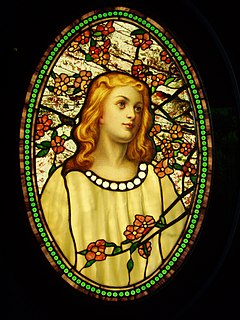
Tiffany glass refers to the many and varied types of glass developed and produced from 1878 to 1933 at the Tiffany Studios in New York, by Louis Comfort Tiffany and a team of other designers, including Frederick Wilson and Clara Driscoll.

Walnut Hills United Presbyterian Church is a historic church tower in the Walnut Hills neighborhood of Cincinnati, Ohio, United States. The last remnant of a landmark church building, it was designed by a leading Cincinnati architect and built in the 1880s. Although named a historic site a century after its construction, the building was mostly destroyed after extensive neglect caused restoration to become prohibitively expensive.

Rugby Chapel is a municipal historic site which is part of the University of Saskatchewan. The U of S is the largest education institution in the Canadian province of Saskatchewan. The University of Saskatchewan location next to the South Saskatchewan River was across from the city centre of Saskatoon. In 1879, the Rt. Rev. John McLean started a schooling system in Prince Albert which was renamed the University of Saskatchewan in 1883. In 1909, when the University of Saskatchewan was established in Saskatoon, Emmanuel College moved its college buildings to Saskatoon. The Institute for stained glass in Canada has documented the stained glass at Rugby Chapel.

All Saints Church is an historic Episcopal church located at 51 Concord Street in Peterborough, New Hampshire, in the United States. Completed in 1914, it is a completely realized example of an English country church as interpreted by the architect Ralph Adams Cram. On December 1, 1980, it was added to the National Register of Historic Places.

St. Andrew's Episcopal Chapel is an historic Episcopal chapel located at Sudlersville, Queen Anne's County, Maryland, built as a chapel of ease for St. Luke's Church in Church Hill. It was listed on the National Register of Historic Places in 1984.

The Cathedral Church of Saint Margaret, also known as Ayr Cathedral, is a Roman Catholic cathedral located in Ayr, Scotland. It is the seat of the Bishop of Galloway, and the mother church of the Roman Catholic Diocese of Galloway. St Margaret's was designated a cathedral in 2007, and is the most recent church to be given status as a Roman Catholic cathedral in the United Kingdom, due to the closure of Good Shepherd Cathedral, Ayr.

The Clarendon Congregational Church is a historic church building at 298 Middle Road in Clarendon, Vermont. Built in 1824 and modified with Gothic features in the 1880s, it is a well-preserved 19th-century brick church. The building was listed on the National Register of Historic Places in 1984. The present minister is Rev. Bill Kingsley.
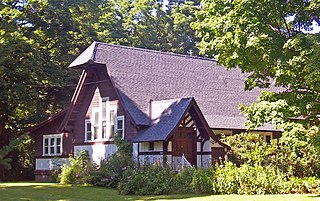
The former Trinity Episcopal Church is located on NY 23B in Claverack, New York, United States. It is a Shingle Style church building from the early 20th century.

St. Aloysius of Gonzaga Church is a Roman Catholic church in Nashua, New Hampshire, United States. The church is part of the Roman Catholic Diocese of Manchester, New Hampshire.

Holy Trinity Platt Church, is in Platt Fields Park in Rusholme, Manchester, England. It is an active Anglican parish church in the deanery of Hulme, the archdeaconry of Manchester, and the diocese of Manchester. The church is recorded in the National Heritage List for England as a designated Grade II* listed building. It is the second "pot church" designed by Edmund Sharpe, so-called because the main building material used in the construction of the church is terracotta.

First Presbyterian Church is located in Marion, Iowa, United States. It was listed on the National Register of Historic Places in 1992.
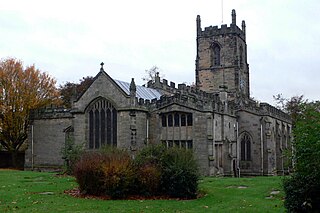
St Helen's Church is the Anglican parish church of Ashby-de-la-Zouch, in the deanery of North West Leicestershire and the Diocese of Leicester. There was a church in the town in the 11th century, but the core of the present building mainly dates from work started in 1474, when the church was rebuilt by William Hastings at the same time that he converted his neighbouring manor house into a castle. The church was refurbished in about 1670 to create more space, but the large and increasing size of the congregation led to further work in 1829, and a major rebuild in 1878–80, including the widening of the nave by the addition of two outer aisles.
St. Luke's Episcopal Church is a parish of the Episcopal Church of America located in Vancouver, Washington. The parish is part of the Episcopal Diocese of Olympia and traces its roots to the initial arrival of Anglican worshippers at Fort Vancouver in the Oregon Country in the 1830s; its first dedicated church building was consecrated in 1860.

All Saints' Church, is a Grade I listed parish church in the Church of England in Babworth, Nottinghamshire.
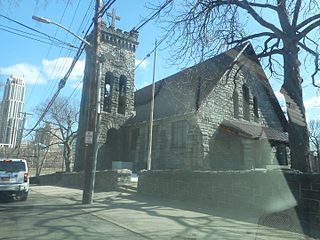
The Parish of St. Gabriel and of St. Joseph was formed in August 2015 with the merger of the Territorial parish of St. Gabriel on Division Street with the personal parish of St. Joseph on Washington Avenue, both in New Rochelle, NY. St. Gabriel is the parish church. However, St. Joseph "will maintain a regular schedule of Masses and the celebration of other sacraments". Both parishes were established around 1900 through the generosity of the Iselin family.

Mount Pisgah Lutheran Church, also known in its early years as the First Lutheran Church and First English Lutheran Church and more recently as The Sanctuary on Penn, is located at 701 North Pennsylvania Street in downtown Indianapolis, Indiana. The historic church was built by the city's first Lutheran congregation, which organized in 1837, and was its third house of worship. The former church, whose present-day name is The Sanctuary on Penn, is operated as a for-profit event venue.




